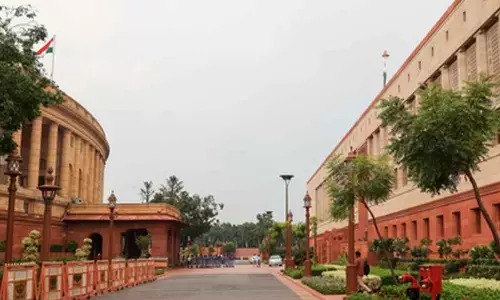390-year-old lamp post throws light on Telangana's medieval trade

Hyderabad: In the surroundings of Mudimanikyam village in Nalgonda district, Telangana, on the tranquil banks of the River Krishna, a remarkable discovery has been made that illuminates the early medieval trade connections of the region. The village, nestled nearly 180 km away from the bustling metropolis of Hyderabad, once fell under the dominion of the Qutub Shahi rulers. This period of history is vividly brought to life through the accounts of European travelers, who traversed the expanse of the Hyderabad kingdom. Among them was the French diamond trader Jean-Baptiste Tavernier, whose journeys to the region spanned five extensive trips within the same era. These travelers, with keen eyes and detailed records, provide invaluable insights into the land trade routes of the time.
Archaeologists, delving into the past, have unearthed a majestic Deepastambham (traditional lamp post), standing tall at 20 feet. This ancient beacon, with niches carved out for lamps, is adorned with inscriptions in multiple languages, offering a new window into the cultural and commercial exchanges of the time.
While Dhwajasthambam (flag poles) are integral to temple architecture across India, signaling the divine presence and marking the threshold to the sacred, the presence of lamp posts within this architectural tradition presents a distinct rarity in the Deccan region. Contrasting sharply with this scarcity, lamp posts find a common place in the temple complexes along the West Coast, including Goa.
M Munirathnam Reddy, Director (Epigraphy), Archaeological Survey of India (ASI), who studied the inscription, says, “The inscription meticulously carved on the lamp post, standing solemnly near the remnants of a Shiva temple, serves as a temporal marker, dating this historical artifact back to June 1635. This inscription, a linguistic blend of Telugu and Tamil, not only reveals the era of its origin but also sheds light on the cultural intermingling present at the time.
Dedicated to Kasi Viswanatha, this towering pillar, with its significant height, transcended its spiritual purpose, doubling as a beacon of guidance for navigators along the bustling riverine trade route. Its strategic placement and lofty stature would have made it an indispensable lighthouse for traders and travelers, illuminating their path and safeguarding their journeys along the vital commercial arteries of the region.” The inscription was engraved by Madiraju Narasayya of Yidupulapati and erected by Polinedu, son of Vali Munulayya.














